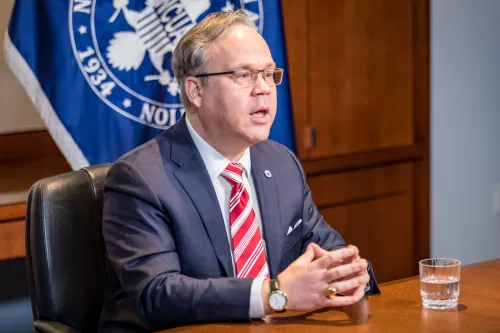NCUA Chairman Todd M. Harper at the NCUA's headquarters at Alexandria, Virginia.
As Prepared For Delivery on November 18, 2021
Thank you, Elizabeth, for your presentation about this final rule on the requirements for shared service facilities. I very much appreciate your hard work on this issue.
While I opposed the proposed rule issued last December, I will join my fellow Board members in support of this final rule because we have corrected the deficiencies contained in the original plan and because the rulemaking has the potential to expand access to safe, fair, and affordable financial services to individuals, including those who live in underserved communities.
Notably, unlike the possibility allowed in the proposed rule, we will not allow credit union websites and banking applications on mobile phones to be considered a service facility for a multiple-bond federal credit union. And, we will not allow leased ATMs that primarily distribute cash to count as a service facility in an underserved area.
As revised, the final rule modernizes requirements related to service facilities for multiple common-bond federal credit unions. For the purposes of adding groups, the final rule provides that shared locations are service facilities, regardless of whether the federal credit union has an ownership interest in the shared branching network providing the locations.
And, for purposes of a multiple common-bond federal credit union adding underserved areas, the final rule defines shared locations to include electronic facilities such as video teller machines or similar types of kiosks regardless of whether the federal credit union has an ownership interest. To be eligible, such electronic service facilities must at least be able to take deposits, accept loan applications, and distribute loans.
As I noted earlier, the federal credit union need not be an owner of the shared branch network for the shared branch or shared video teller or kiosk to be a service facility. During this review process, I learned that it does not always make business sense for a credit union to own an electronic facility, because of ever evolving technology and the cost of continually upgrading obsolete technology.
Additionally, during the consideration of the proposed rule, I noted that a leased ATM would not serve the needs of an under-resourced community well. The residents of these communities often prefer, and need, more personalized service. A recent National Survey of Mortgage Originations conducted by two of our sister agencies bolsters that point. In 2019 and early 2020, credit union members were much more likely than non-credit union members to prefer having a branch nearby, and these figures were the highest for those with the lowest credit scores.
While an electronic kiosk or video teller may not have an actual person present on the premises, they will allow for greater interaction between a credit union and a member in an underserved area. The provisions in the final rule for three essential financial services that an eligible electronic facility must provide mitigated my initial concerns about having personalized service.
We must also recognize that the financial services system is evolving to provide more and more services electronically. Consistent with the law, we must keep up with these technological changes. By allowing certain electronic facilities providing more robust services, but not allowing minimal-service ATMs to count as a service facility in an underserved area, we are fulfilling our obligations under the Federal Credit Union Act. And, credit unions of all types must also continue to refrain from redlining practices under fair lending laws.
Finally, under this final rule, the Chartering Manual will continue to require a credit union adding an underserved area to its field of membership to “establish within two years, and maintain, an office or service facility in the community.” Elizabeth, could you please explain what would happen if a shared service facility closes?
Thank you for that clarification. In cases where a shared facility closes, our examiners will expect the credit union operating in an underserved area to move quickly to restore services.
In conclusion, my concerns about the legal underpinning of this final rule have been resolved by removing internet websites and mobile applications from being considered service facilities and by the strength of the “establish and maintain” a facility with core services requirement. Therefore, I support this final rule.
I have no further remarks. I now recognize Vice Chairman Hauptman.



